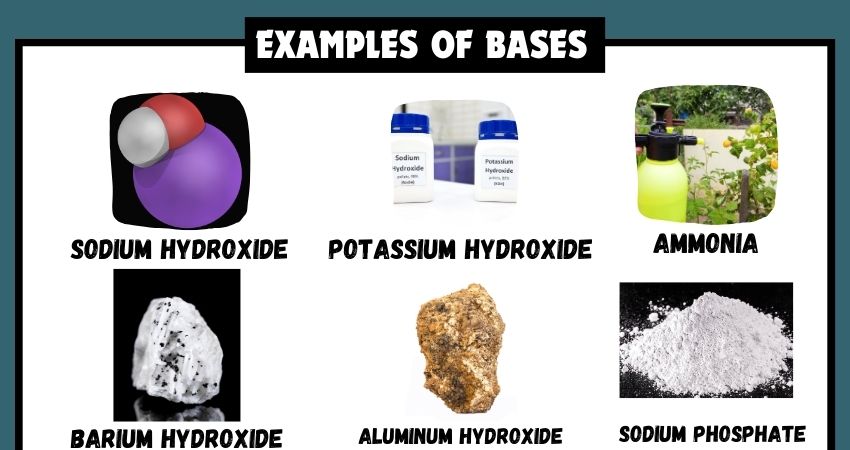Bases are chemical compounds that have a pH value greater than 7, accept protons, and turn red litmus blue. They are essential in daily life for various reasons:
- Household cleaning: Bases such as drain cleaners, laundry detergents, and soaps are used for cleaning purposes.
- Personal care products: Bases are present in products like toothpaste and antacids, which are used for oral hygiene and to neutralize excess stomach acid.
- Food preparation: Bases like baking soda are used in cooking and baking. They can also be found in certain food items, such as sugar and cocoa, to balance their acidity.
- Healthcare: Bases are used in the pharmaceutical industry to produce medications and in the manufacture of medical products such as surgical dressings.
- Industrial applications: Bases are used in various industrial processes, including the production of fertilizers, explosives, and chemicals.
In summary, bases are an integral part of daily life, with applications ranging from household cleaning to food preparation and industrial processes. Their ability to neutralize acids and their presence in a wide range of products make them indispensable in numerous aspects of everyday living.
Examples of Bases
Bases, in the realm of chemistry, are substances characterized by their ability to accept protons (H⁺ ions) or donate pairs of electrons. Here are 20 Examples of Bases;
Sodium Hydroxide (NaOH)
Sodium hydroxide, commonly known as caustic soda, is a strong base widely used in industrial processes. It’s involved in the production of various chemicals and serves as a key ingredient in soap and detergent manufacturing.
Potassium Hydroxide (KOH)
Potassium hydroxide, or caustic potash, is another potent base with applications in the production of fertilizers, detergents, and pharmaceuticals. It is also utilized in the food industry for processes such as cocoa processing.
Calcium Hydroxide (Ca(OH)2)
Calcium hydroxide, known as slaked lime, is used in construction for mortar and plaster. In agriculture, it is employed to neutralize acidic soils, promoting better plant growth.
Magnesium Hydroxide (Mg(OH)2)
Magnesium hydroxide, a white solid, has applications as an antacid to neutralize stomach acid. It is also utilized as a flame retardant in plastics.
Ammonia (NH3)
Ammonia, while commonly associated with being a base, is unique as it can act as both a base and a nucleophile. It finds applications in refrigeration, fertilizer production, and as a cleaning agent.
Sodium Bicarbonate (NaHCO3)
Sodium bicarbonate, or baking soda, is a versatile base used in cooking, as an antacid, and in fire extinguishers. It reacts with acids to produce carbon dioxide, causing baked goods to rise.
Sodium Carbonate (Na2CO3)
Sodium carbonate, also known as soda ash, is employed in the glass industry, water treatment, and as a pH regulator in various chemical processes.
Sodium Hypochlorite (NaClO)
Sodium hypochlorite is a base commonly known as bleach. It serves as a disinfectant, and stain remover, and is used in water treatment to sanitize drinking water.
Sodium Phosphate (Na3PO4)
Sodium phosphate is utilized in detergents, food processing, and as a water softener. It also plays a role in buffering solutions in laboratories.
Aluminum Hydroxide (Al(OH)3)
Aluminum hydroxide is employed as an antacid to neutralize stomach acid. It is also used as a flame retardant in certain materials.
Lithium Hydroxide (LiOH)
Lithium hydroxide is used in the production of lithium-based greases, which find application in lubricating various types of machinery.
Barium Hydroxide (Ba(OH)2)
Barium hydroxide is utilized in laboratories for titration purposes. It is also used in the manufacture of certain types of glass.
Rubidium Hydroxide (RbOH)
Rubidium hydroxide is a strong base used in research laboratories, particularly in the fields of chemistry and physics.
Cesium Hydroxide (CsOH)
Cesium hydroxide, while less common, finds applications in research and specialized chemical processes.
Strontium Hydroxide (Sr(OH)2)
Strontium hydroxide is used in the production of certain types of glass and as a catalyst in organic synthesis.
Calcium Carbonate (CaCO3)
Calcium carbonate, although primarily known as a base, also serves as a common mineral in the formation of limestone and marble.
Potassium Carbonate (K2CO3)
Potassium carbonate is employed in the production of soap and glass. It also has applications in the food industry.
Sodium Acetate (C2H3NaO2)
Sodium acetate is used in the textile industry as a neutralizing agent and as a component in hot packs for heat therapy.
Sodium Sulfide (Na2S)
Sodium sulfide is a strong base used in the production of chemicals and the leather industry for removing hair from hides.
Sodium Hypobromite (NaBrO)
Sodium hypobromite is employed in the synthesis of certain pharmaceuticals and as a disinfectant in water treatment.
Properties of Bases

Bases, in chemistry, exhibit distinct physical and chemical characteristics that differentiate them from acids. Understanding these properties is crucial for comprehending their behavior in various contexts.
Physical Properties
- Taste and Touch:
Bases generally have a bitter taste and a slippery or soapy feel when touched. However, tasting or touching strong bases is not recommended due to potential harm. - Solubility:
Many bases dissolve in water, forming aqueous solutions. The solubility varies among different bases, influencing their applications and uses. - Conductivity:
Aqueous solutions of bases conduct electricity due to the presence of ions, particularly hydroxide ions (OH⁻). The conductivity is typically less than that of strong acids. - Color:
Bases may impart specific colors to indicators. For example, litmus paper turns blue in the presence of a base.
Chemical Properties
- Reactivity with Acids:
Bases react with acids to form water and salts in a process known as neutralization. This reaction is essential in various industrial and laboratory applications. - Formation of Hydroxide Ions:
Bases, when dissolved in water, release hydroxide ions (OH⁻). This characteristic distinguishes them from acids, which release hydrogen ions (H⁺). - Metallic Oxide Formation:
Many bases react with metal oxides to form salts and water. This property is exploited in the metallurgical industry. - Turn Phenolphthalein Pink:
Phenolphthalein, an indicator, turns pink in the presence of bases. This color change is utilized to identify the endpoint of titrations. - Amphoteric Nature:
Some bases, like aluminum hydroxide, exhibit amphoteric behavior, meaning they can act as both bases and acids depending on the circumstances.
Understanding the physical and chemical properties of bases is essential for their safe handling, precise utilization in reactions, and recognizing their role in various chemical processes.
Uses of Bases
Bases play a crucial role in various applications across industries, households, and the medical field due to their unique chemical properties. Here’s an overview of the diverse uses of bases:
Industrial Uses
- Chemical Manufacturing:
Bases such as sodium hydroxide and potassium hydroxide are integral in the production of numerous chemicals, including detergents, soaps, and fertilizers. - Metal Processing:
Bases are employed in metallurgical processes to extract metals from their ores. They react with metal oxides to form soluble salts. - Water Treatment:
Bases like sodium carbonate are utilized in water treatment to adjust the pH levels and remove impurities, contributing to cleaner and safer water. - Glass Production:
Sodium carbonate and other bases are essential in the manufacture of glass, influencing the glass’s properties and melting characteristics.
Medical Uses
- Antacids:
Bases such as aluminum hydroxide and magnesium hydroxide are common ingredients in antacids, neutralizing excess stomach acid and providing relief from indigestion. - Pharmaceuticals:
Some bases are used in the synthesis of pharmaceuticals, contributing to the creation of various medications and drugs. - Topical Treatments:
Bases may serve as carriers in the formulation of creams and ointments for topical medications, ensuring proper absorption and skin compatibility.
Household Uses
- Cleaning Products:
Bases, particularly sodium hydroxide and ammonia, are key components in household cleaning products, effectively breaking down grease and stains. - Baking and Cooking:
Bases like baking soda (sodium bicarbonate) are used in baking to leaven dough, while other bases may be used in food preparation for various culinary purposes. - Laundry:
Bases contribute to the effectiveness of laundry detergents, aiding in the removal of dirt and stains from clothing.
Safety and Precautions
- Handling Bases:
Proper handling of bases is crucial, and safety measures include wearing protective gear such as gloves and goggles to avoid skin and eye contact. - Disposal of Bases:
Disposal of bases should adhere to environmental regulations, often involving neutralization before disposal to prevent harm to ecosystems.
Understanding the uses of bases is essential for ensuring their efficient and safe application in diverse settings, from industrial processes to everyday household activities.

